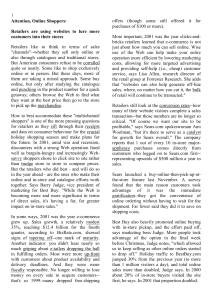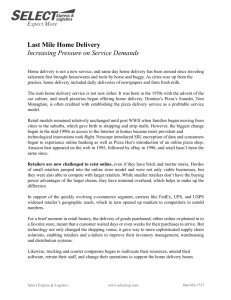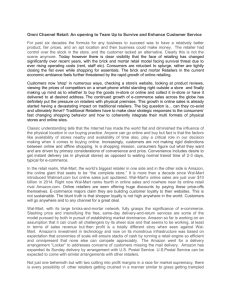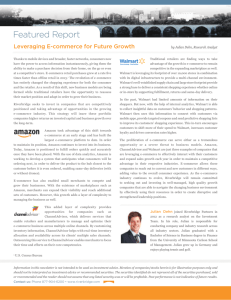Reinventing the Retail Game in Terms of Customer Service and Value
advertisement
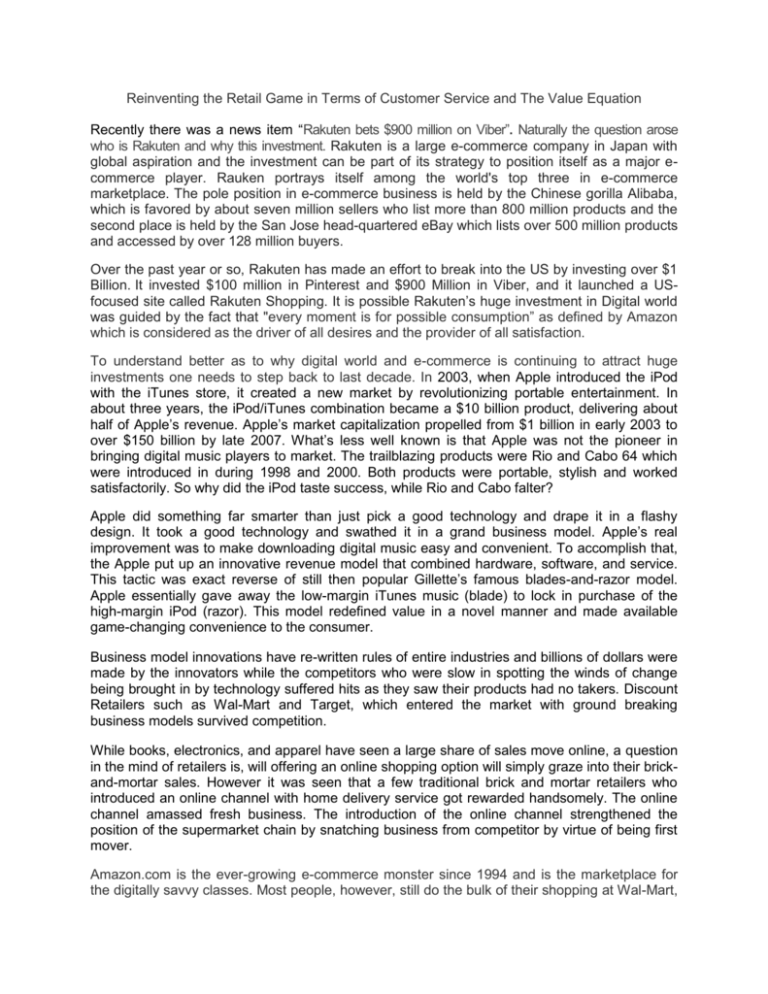
Reinventing the Retail Game in Terms of Customer Service and The Value Equation Recently there was a news item “Rakuten bets $900 million on Viber”. Naturally the question arose who is Rakuten and why this investment. Rakuten is a large e-commerce company in Japan with global aspiration and the investment can be part of its strategy to position itself as a major ecommerce player. Rauken portrays itself among the world's top three in e-commerce marketplace. The pole position in e-commerce business is held by the Chinese gorilla Alibaba, which is favored by about seven million sellers who list more than 800 million products and the second place is held by the San Jose head-quartered eBay which lists over 500 million products and accessed by over 128 million buyers. Over the past year or so, Rakuten has made an effort to break into the US by investing over $1 Billion. It invested $100 million in Pinterest and $900 Million in Viber, and it launched a USfocused site called Rakuten Shopping. It is possible Rakuten’s huge investment in Digital world was guided by the fact that "every moment is for possible consumption” as defined by Amazon which is considered as the driver of all desires and the provider of all satisfaction. To understand better as to why digital world and e-commerce is continuing to attract huge investments one needs to step back to last decade. In 2003, when Apple introduced the iPod with the iTunes store, it created a new market by revolutionizing portable entertainment. In about three years, the iPod/iTunes combination became a $10 billion product, delivering about half of Apple’s revenue. Apple’s market capitalization propelled from $1 billion in early 2003 to over $150 billion by late 2007. What’s less well known is that Apple was not the pioneer in bringing digital music players to market. The trailblazing products were Rio and Cabo 64 which were introduced in during 1998 and 2000. Both products were portable, stylish and worked satisfactorily. So why did the iPod taste success, while Rio and Cabo falter? Apple did something far smarter than just pick a good technology and drape it in a flashy design. It took a good technology and swathed it in a grand business model. Apple’s real improvement was to make downloading digital music easy and convenient. To accomplish that, the Apple put up an innovative revenue model that combined hardware, software, and service. This tactic was exact reverse of still then popular Gillette’s famous blades-and-razor model. Apple essentially gave away the low-margin iTunes music (blade) to lock in purchase of the high-margin iPod (razor). This model redefined value in a novel manner and made available game-changing convenience to the consumer. Business model innovations have re-written rules of entire industries and billions of dollars were made by the innovators while the competitors who were slow in spotting the winds of change being brought in by technology suffered hits as they saw their products had no takers. Discount Retailers such as Wal-Mart and Target, which entered the market with ground breaking business models survived competition. While books, electronics, and apparel have seen a large share of sales move online, a question in the mind of retailers is, will offering an online shopping option will simply graze into their brickand-mortar sales. However it was seen that a few traditional brick and mortar retailers who introduced an online channel with home delivery service got rewarded handsomely. The online channel amassed fresh business. The introduction of the online channel strengthened the position of the supermarket chain by snatching business from competitor by virtue of being first mover. Amazon.com is the ever-growing e-commerce monster since 1994 and is the marketplace for the digitally savvy classes. Most people, however, still do the bulk of their shopping at Wal-Mart, Target and lots of supermarkets and home improvement chain stores. Since coming to age of dot-com revolution during the past decade, online transactions account for a little over 12%of total retail sales. In the digital age, it seems remarkable that bricks-and-mortar retailers have displayed such staying power. Only two pure-play online merchants feature in Top 100 Global Retailers and this clearly shows that traditional retailers still put their substantial might to push goods through the consumer pipeline. Large-format value retailers Wal-Mart Stores, Target Corp, Costco Wholesale, Meijer Inc and BJ’s Wholesale Club, who constitute the top five, collectively generate nearly $500 billion in annual sales revenue. In contrast, Amazon.com and Dell, the pure e-tailers among the Top 100, posted combined revenue of around $131 billion. This muscular show of retail sales does not detract from what Amazon is and what it does best. Amazon wolf down dollars from shopper’s wallet, leaving behind a whole chain of revered retailers gasping for breath. Amazon dominates the world of e-commerce sales. Amazon is involved in many areas to muscle up its business which normally one expect a retail chain to do, like investing in warehouse construction, developing content for its in house brand of electronic devices. Amazon is heavily involved as virtual landlord for all the merchants in its marketplace online shopping mall and is continually upgrading and expanding its technologyfor-hire Web Services business. E-commerce platform providers like Amazon, eBay spare no effort to blur the lines and connect directly with consumers. The differentiator among e-commerce platforms can be significant. Similarly differences between e-commerce platforms and physical stores can be noteworthy. E-commerce is bound to grow as can be seen in the acquisition activity of traditional storebased retailers like Wal-Mart and Target as they grow their own e-commerce businesses. In December 2012 TJX, acquired online merchant Sierra Trading Post for $200 million. Wal-Mart, Macy’s, Walgreens and a number of other operators are using their bricks-and-mortar stores to promote selling goods in whatever channel customers choose to shop, with the reassuring notion that “You know where you can find us if ever your Digital connection goes down.” E–commerce channel of Wal-Mart delivers only about 2 % of its global revenue but in absolute terms it amounts to $9 billion which is equivalent to roughly one-seventh of Amazon’s worldwide retail sales. Macy’s is the second-largest traditional retailer in terms of e-commerce revenue, a spot upon which it looks for reaching the pole position. Bricks-and-mortar retailers are also looking to exploit their inherent advantages. Convenience is certainly one of them — not just being in the shoppers neighborhood, but also that the items get delivered at home when they are purchased. Every year more than a billion devices are getting connected to the Internet. By next five years, there will be more than 50 billion connected stuffs like Smartphone and wearable smart devices. And behind every device, there is a customer. Customers have never been so close to seller, yet companies still struggle to connect with them. Any retailer who makes it easy for shoppers to return to the site again and again will be making a good pick of shopper’s wallet and this is reflected when one takes a look at Amazon’s revenue in excess of $74 billion. Amazon’s user friendly digital interface makes navigation convenient, shoppers get drawn to it and this made Amazon.com as the favorite online retailer of savvy e-shoppers. eBay.com, Kohls.com and BestBuy.com are the others who are names to recon as online retailers. Millions has been invested by Wal-Mart over the last few years acquiring online companies and buff up its web expertise. Also, others who have built their businesses in the bricks-and-mortar realm are deploying technology with the intent of being better in meeting — if not exceeding — the expectations of consumers who want the same level of satisfaction experience across all platforms. Companies specializing in plus-size apparel appear among the most preferred online retailers, signifying that this group of shoppers may be under-served in the bricks-and-mortar realm — or prefer the privacy shopping that a digital platform allows. For big-ticket purchases, shoppers are more inclined to research and digital shopping experiences continue to influence purchasing behavior: Shoppers regularly compare prices and purchase from another retailer while shopping in a store. This is a vital aspect in which Amazon.com scores high. Just as Google is a prime search engine, Amazon.com is the first place one think of when one wants something. When one look for retailers who are adept at harnessing the notion of social shopping and sharing, it’s clear that the power of customer engagement has paid dividends on so many fronts. Social media's power to influence what people buy is widely recognized and in coming years it will also influence what retailers sell Innovation should be at the core of the retailer’s identity in their focus on providing most attractive bargain to shoppers. (By Moorthi – Morison Menon)
